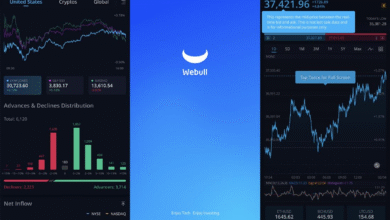Prediction Markets Show Hassett and Warsh for Fed Chair

Prediction markets have emerged as a fascinating tool for gauging public sentiment and forecasting outcomes, especially in political contexts like the potential leadership of the Federal Reserve. Recently, comments from Donald Trump regarding Fed chair candidates Kevin Hassett and Kevin Warsh have ignited speculation within these markets, driving bets on who might replace Jerome Powell as the next central bank leader. Following Trump’s praise for the ‘Kevins,’ the prediction markets notably adjusted, giving Hassett and Warsh each a 35% chance of being selected, with current Fed Governor Christopher Waller trailing at 15%. This dynamic showcases how prediction markets can manifest collective intelligence, reflecting both expert opinions and public sentiment regarding significant appointments. As interest rates remain a hot topic of debate, tracking these markets offers valuable insights into potential economic shifts and policy directions that could shape the future under new Fed leadership.
Forecasting platforms, commonly known as prediction markets, serve as an innovative mechanism to predict outcomes through collective betting pools. These markets have recently been buzzing with speculation about possible candidates to take over the reins of the Federal Reserve, particularly in light of President Trump’s favorable remarks about potential successors such as Kevin Hassett and Kevin Warsh. By placing their bets, participants express their expectations for who might succeed Jerome Powell, positioned as a pivotal figure in shaping monetary policy. This nuanced interplay of opinion and financial stakes within prediction markets provides a unique lens into how economic leadership could evolve under possible contenders for the Fed chair. With ongoing discussions about interest rate adjustments, these platforms not only highlight potential future decisions but also reflect broader market sentiment.
Trump’s Praise for Fed Chair Candidates
In a recent interview on CNBC’s ‘Squawk Box,’ President Donald Trump expressed strong support for two potential candidates to replace Jerome Powell as the next chair of the Federal Reserve: Kevin Hassett and Kevin Warsh. Trump described them as ‘very good’ choices, reflecting his confidence in their capabilities to lead the central bank. This endorsement has significantly impacted public perception and speculation regarding their possible appointment, especially given the current economic climate that necessitates profound leadership and insightful monetary policy adjustments.
The President’s backing of Hassett and Warsh has also influenced predictions in the markets, particularly with platforms like Kalshi, where these candidates have seen a surge in betting odds following Trump’s remarks. Their qualifications and past experiences are crucial elements in the discourse surrounding their candidacy. Despite Trump mentioning them as preferred candidates, there remains uncertainty and debate about their potential effectiveness once in office.
Prediction Markets and the Fed Chair Race
Prediction markets have become a popular tool for gauging public sentiment regarding leadership changes at major financial institutions, including the Federal Reserve. The recent shifts in these markets indicate a robust interest in who may replace Jerome Powell, whom Trump has criticized for maintaining elevated interest rates. Following Trump’s admiration for the ‘Kevins,’ Hassett and Warsh, both have seen their probabilities climb to 35% on Kalshi, suggesting that market participants find substantial value in these endorsements, viewing them as serious contenders.
Additionally, the mechanics of prediction markets allow traders to bet on outcomes like appointments in real-time, making them an intriguing gauge of potential political developments. Even as the public keeps a close eye on Hassett and Warsh, other candidates like Christopher Waller and Judy Shelton share the spotlight, with their odds reflecting varying levels of support, but Trump’s focus on the ‘Kevins’ has undoubtedly invigorated their chances.
Key Figures in Fed Leadership Controversy
Aside from Hassett and Warsh, other individuals like Christopher Waller and Treasury Secretary Scott Bessent have emerged as notable figures within this leadership debate. Waller, the current Fed Governor, has seen a decrease in his betting odds post-Trump’s interview, reflecting the uncertainties raised by the President’s comments. This dynamic demonstrates how closely intertwined political opinions and prediction markets can be when it comes to critical economic leadership positions.
Bessent’s withdrawal from the race further complicates the landscape, leaving room for new candidates to emerge as serious contenders. The ongoing speculation and public commentary highlight the importance of these leadership roles, especially given the Fed’s significant influence on the economy. As markets adjust and react to political evaluations, the pressure is mounting for the candidates to not only maintain their current standings but to actively campaign for the trust and confidence of both the public and political power players.
Economic Implications of Fed Chair Appointment
The appointment of the next Fed chair comes with substantial economic implications, particularly regarding interest rates and monetary policy. Both Kevin Hassett and Kevin Warsh have voiced their support for strategies that prioritize rate cuts—a point that resonates with Trump’s broader economic strategies aimed at stimulating the economy. A shift in Fed leadership could drastically reshape monetary policy, influencing everything from inflation rates to employment figures in the U.S.
With Powell’s term concluding in May 2026, the focus on a potential transition in leadership presents a pivotal moment for the nation’s economic direction. The market’s reaction to speculation about the Fed chair position reflects broader concerns about stability, growth, and inflationary pressures. Observers are eagerly considering how Hassett or Warsh’s proposed policies might differ from Powell’s, thus altering the Fed’s approach to interest rates that have attracted scrutiny from Trump and other critics.
The Impact of Trump’s Endorsements
Trump’s open support for Hassett and Warsh plays a crucial role in shaping public opinion and betting behaviors in prediction markets. His comments convey a sense of urgency and possibility regarding these candidates, which can translate into increased investor confidence or anxiety depending on how closely people align with Trump’s views. Such endorsements not only influence market dynamics but also signal potential alignments of policy direction, proposing an intriguing narrative concerning the future of U.S. monetary policy.
The significant sway Trump holds over potential Fed chair candidates illustrates the interplay between politics and economics. As bets on prediction markets illustrate shifts in favor of Hassett and Warsh, it raises questions about the underlying ideological battles that will unfold as candidates vie for the position. With the backdrop of election discussions and economic considerations, these endorsements heighten the anticipation surrounding the future trajectory of monetary policy.
Comparative Analysis of Fed Chair Candidates
An examination of the potential candidates—Kevin Hassett, Kevin Warsh, Christopher Waller, and Judy Shelton—reveals varying philosophies and experiences that could impact the Federal Reserve’s future decision-making process. For instance, while Hassett and Warsh advocate for looser monetary policies, Waller’s positioning suggests a more cautious approach. This divergence indicates how the appointment could pivot U.S. economic strategies significantly based on who secures the role.
Moreover, contrasting the support these candidates receive in prediction markets provides valuable insights into their public perceptions. The prominent focus on Hassett and Warsh in recent discussions showcases their perceived viability, while Waller’s odds have slipped, reflecting less optimism in his potential selection following Trump’s definitiveness towards the other two contenders. These insights contribute to broader discussions surrounding fiscal policies and their implications for economic health.
Market Predictions Following Leadership Speculation
The speculation surrounding the next Fed chair has sparked a flurry of activity within prediction markets. As President Trump has made his preferences known, insiders and traders alike have responded, betting on the ‘Kevins’ to lead the central bank. These shifts illustrate a broader trend within markets that closely track political endorsement and public sentiment, easily translating into financial predictions and outcomes.
As discussions unfold leading up to the formal announcement of Powell’s successor, market participants will continue to analyze potential impacts on various sectors, from equities to bonds. This demonstrates how leadership at the Federal Reserve extends beyond appointments, fundamentally affecting the financial landscape for investors, corporations, and the economy.
Future Implications of a New Fed Chair
The eventual appointment of a new Fed chair will carry long-term implications for U.S. economic policy and global financial stability. With interest rates and monetary policies being central to this discussion, both Trump and the markets are underlining the urgency for effective leadership in the wake of rising inflation and economic pressures. Depending on who is appointed, the strategies undertaken could lead to varying outcomes for the economy, highlighting the high stakes involved in this appointment.
As markets react to the potential candidates, the economic projections tied to their leadership could reverberate across various sectors. Understanding the attributes and ideologies of Hassett and Warsh gives investors a lens through which to interpret future monetary policy decisions and their broader implications for financial markets. The countdown to the announcement remains critical as stakeholders weigh their options amidst an evolving economic landscape.
Conclusion: The Race for the Fed Chair Position
In conclusion, the race to succeed Jerome Powell as Fed chair is heating up, particularly as President Trump sheds light on his preferred candidates. With wagering on prediction markets heavily favoring Kevin Hassett and Kevin Warsh, the importance of aligning economic strategies with market expectations cannot be overstated. Their potential nomination could significantly shift the Fed’s approach to interest rates and economic interventions.
As we approach the conclusion of Powell’s term, the attention on these candidates underscores the intricate relationship between politics and monetary policy. The decisions made during this transition will be pivotal in shaping the future economic landscape, thus making it a critical area to watch for stakeholders across various sectors.
Frequently Asked Questions
What are prediction markets and how can they help forecast Fed chair candidates?
Prediction markets are platforms that allow individuals to place bets on the outcomes of future events, such as who will be the next Fed chair. Market participants gauge the likelihood of candidates like Kevin Hassett and Kevin Warsh based on real-time sentiment, making it a valuable tool for understanding potential shifts in Federal Reserve leadership.
Who are the leading candidates for Fed chair according to prediction markets?
As of now, prediction markets show Kevin Hassett and Kevin Warsh as the front-runners for Fed chair, each with a 35% chance of being selected. Current Fed Governor Christopher Waller and former economic advisor Judy Shelton also appear in discussions, but with lower odds.
How has Trump influenced prediction markets regarding the next Fed chair?
President Trump’s recent praise for Kevin Hassett and Kevin Warsh during an interview significantly impacted prediction markets. Following his comments, their chances of becoming the next Fed chair increased sharply, reflecting the weight of his endorsements in the market dynamics.
What role do prediction markets play in assessing Jerome Powell’s replacement?
Prediction markets provide insight into who may replace Jerome Powell as Fed chair, with real-time betting odds reflecting public sentiment and expert opinions. Candidates like Hassett and Warsh are gaining traction in these markets, highlighting their potential to lead the Federal Reserve.
What are the implications of Trump’s comments on Fed chair candidates in prediction markets?
Trump’s remarks have shifted prediction market trajectories, enhancing the profiles of candidates like Hassett and Warsh. Such endorsements can sway investor sentiment and financial forecasts related to the Federal Reserve’s future direction, showcasing how political discourse impacts economic predictions.
How can I participate in prediction markets for Fed chair candidates?
You can participate in prediction markets by joining platforms like Kalshi that allow users to bet on political events and outcomes, including potential Fed chair candidates such as Kevin Hassett and Kevin Warsh. Make sure to review the rules and regulations governing such markets before engaging.
What are the chances of other candidates like Chris Waller and Judy Shelton in prediction markets?
Current prediction markets indicate that Chris Waller has a 15% chance of becoming the next Fed chair, while Judy Shelton has around a 6% probability. These figures reflect market sentiment and are influenced by recent political developments and public discussions.
Why is tracking prediction markets important for understanding the Federal Reserve?
Tracking prediction markets is crucial for gauging public sentiment and expectations regarding the Federal Reserve’s leadership, particularly concerning candidates like Hassett and Warsh. These insights can help investors and analysts prepare for potential shifts in monetary policy direction.
| Key Point | Details |
|---|---|
| Potential Candidates | Kevin Hassett, Kevin Warsh, Christopher Waller, and Scott Bessent were mentioned as front-runners for the Fed chair role. |
| Trump’s Comments | Trump praised Hassett and Warsh in an interview on CNBC’s ‘Squawk Box’, calling both Kevins ‘very good’. |
| Prediction Market Shifts | After Trump’s remarks, both Hassett and Warsh received a 35% chance of being selected as Fed chair on Kalshi. |
| Waller’s Odds | Waller’s chances of selection dropped to 15%, not being mentioned by Trump. |
| Trump’s Criticism of Powell | Current Fed Chair Jerome Powell has faced criticism from Trump for his elevated interest rates. |
| Kugler’s Resignation | Fed Governor Adriana Kugler’s resignation creates an opportunity for Trump to appoint a new member to the Fed. |
| Other Candidates | Judy Shelton has a 6% chance, and David Malpass has a 4% chance based on prediction markets. |
| Trump’s Own Odds | Surprisingly, Trump himself received a 1% preference for leading the Fed on Kalshi. |
Summary
Prediction markets indicate significant shifts in the potential candidates for the role of Fed chair following President Trump’s recent praises for Kevin Hassett and Kevin Warsh. The speculation ignited by Trump’s comments has led to considerable movement in betting odds, suggesting that Hassett and Warsh are now the prominent figures in the running. As the current chair’s term approaches its end, the dynamics within prediction markets remain essential for anticipating the future leadership of the Federal Reserve, potentially impacting financial decisions and policies.




